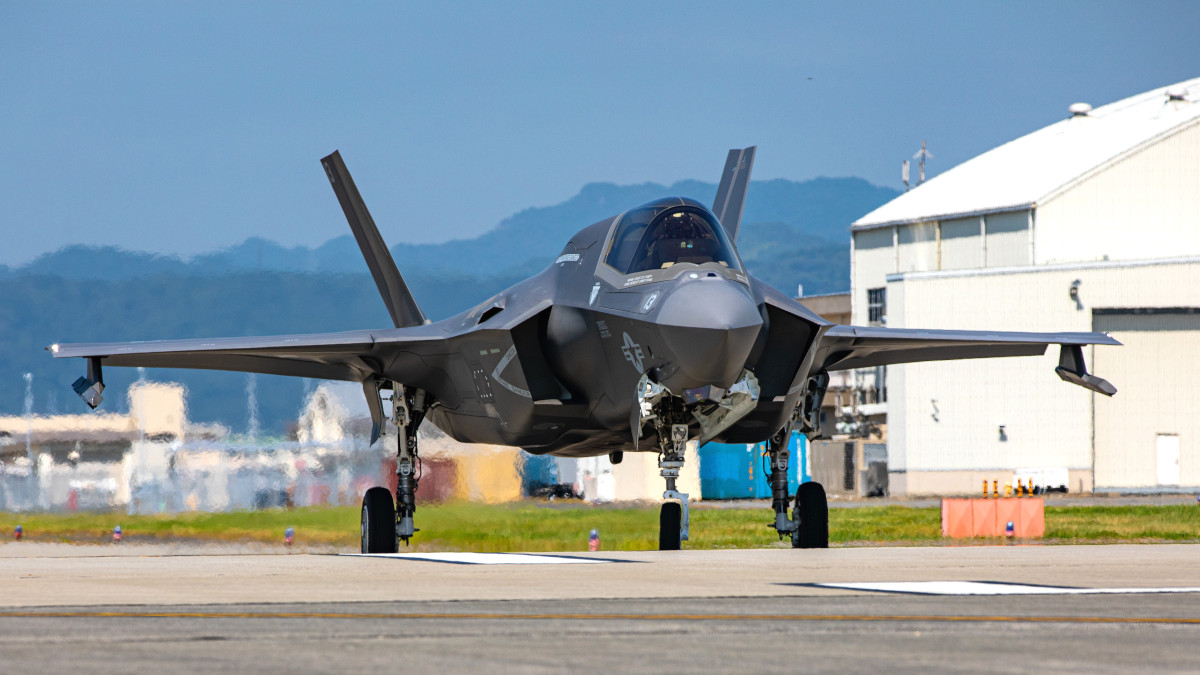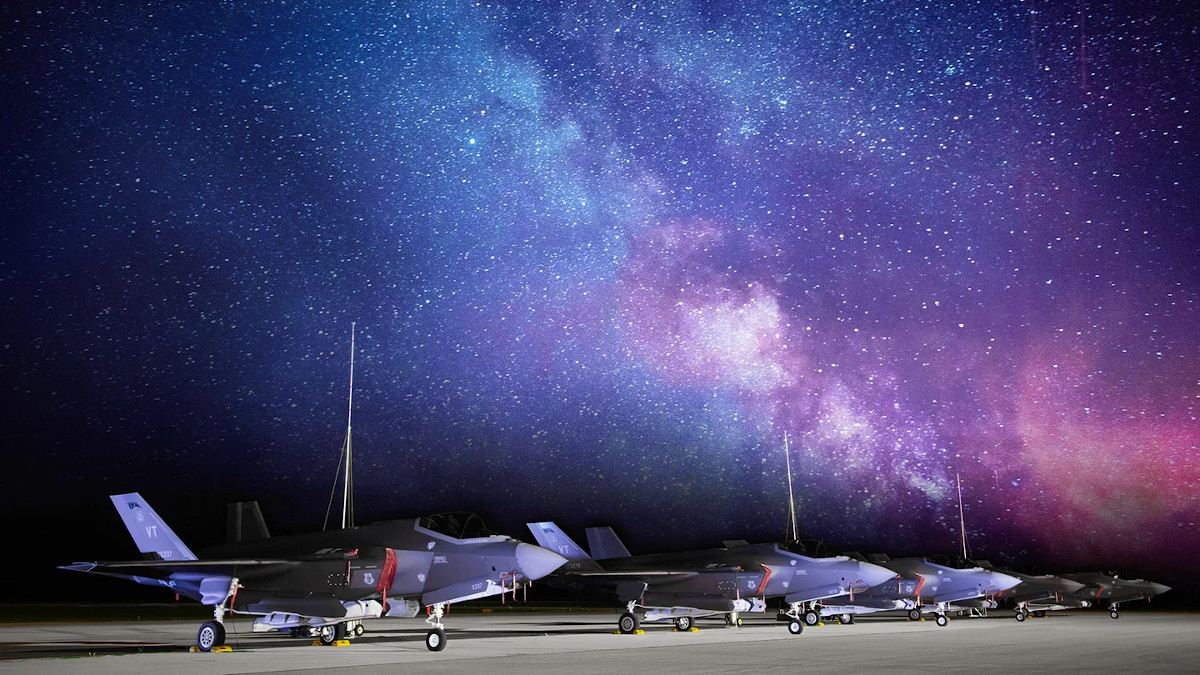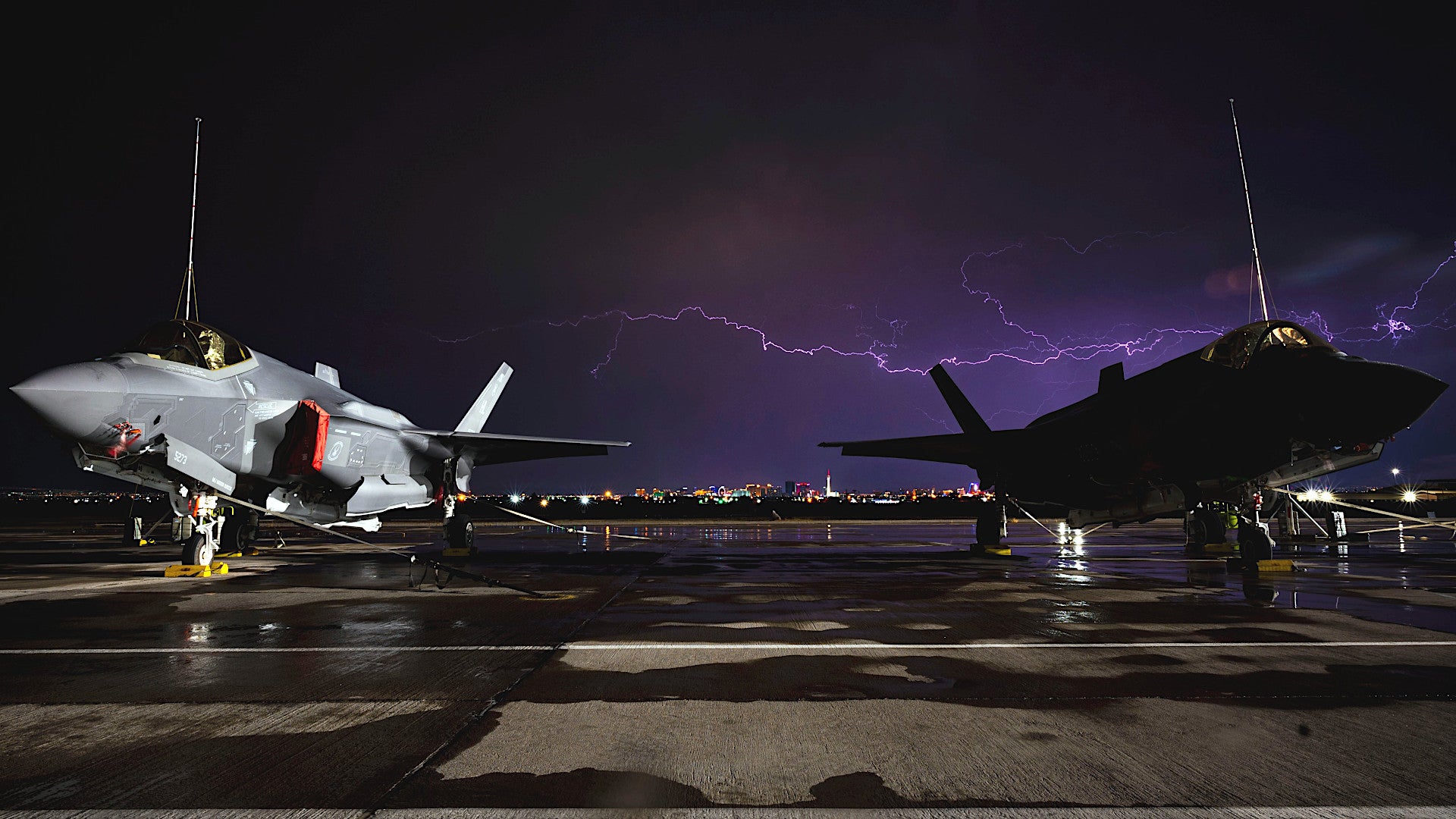Nellis Air Force Base’s official Twitter account has posted a great picture of a pair of U.S. Air Force F-35A Joint Strike Fighters, also known by the official nickname Lightning II, protected by lightning rods as actual lightning striking in the background. The Tweet, which asks “which lightning do you think strikes harder?”, comes just days after the U.S. Marine Corps revealed that a pair of their F-35Bs were grounded in Japan with millions of dollars in damage after being hit by lightning during sorties earlier this month. Air Force F-35As have also infamously been banned, at least in the past, from flying anywhere near thunderstorms due to concerns about the potential for their fuel systems to explode if they are struck by lightning.
The picture in the Tweet shows a pair of F-35As from Hill Air Force Base in Utah, home to the 388th and 419th Fighter Wings, both of which are equipped with Joint Strike Fighters. The jets are at Nellis, which is situated on the outskirts of Las Vegas, Nevada, taking part in the Red Flag 21-3 exercise, which began on July 19 and runs through Aug. 6.

“These F-35 Lightning IIs from @hafb were parked on the @NellisAFB flight line during last night’s #Vegas storm,” the Tweet reads, in part. “Today, they’re ready to rumble for #RedFlag 21-3.”
Red Flags are run multiple times each year out of this base and are conducted over the adjacent sprawling Nevada Test and Training Range (NTTR). They are major air warfare exercises that typically involve a wide array of different Air Force aircraft types, as well as elements from the U.S. Navy and Marine Corps.
Foreign allies and partners often take part, as well, though Red Flag 21-3 appears to be entirely, or almost entirely, an American event. Red Flags with limited international participation usually coincide with the employment of more advanced capabilities. F-117 Nighthawk stealth combat jets have notably been participating in this current exercise. Despite all of the remaining F-117s having been officially retired, and what’s left of the fleet ostensibly destined to be placed in museums or scrapped, a number of them have been flying as “red air” aggressors in support of various exercises for some time now.
The Tweet is certainly meant to be lighthearted, but the prompt “which lightning do you think strikes harder?” is also ironic given the current state of the two Marine F-35Bs based at Marine Corps Air Station Iwakuni in Japan. Last week, the Marine Corps confirmed that both jets were struck by lightning during a flight on July 13, but that they were thankfully able to land safely and that neither of the pilots were injured.
“After conducting our standard reporting and assessment procedures, the weather-related incident was labeled as a class ‘A’ mishap due to the combined projected repair costs exceeding two and a half million U.S. dollars,” U.S. Marine Corps Captain Marco Valenzuela, a spokesperson for Marine Air Group 12 at Iwakuni, said in a statement to Marine Corps Times. “The safe operation of our aircraft and the readiness of our squadrons are vitally important to us in order to continue supporting our allies, partners, and joint forces in the region.”

In the U.S. military’s system for categorizing aviation mishaps, a Class A incident is the most severe and is any accident that results in at least $2.5 million in property damage, leads to the total loss of the aircraft, or leaves one or more individuals dead or permanently disabled. Marine Corps Times’ report does not provide specific details about the damage to either F-35B.
However, past contracting documents have outlined how the stealthy composite material skin on all F-35 variants “does not provide inherent passive lightning protection,” unlike metal-clad aircraft. The potential risks posed by lightning strikes exist on the ground, as well as in the air, and the F-35As seen in the picture from Nellis are notably seen parked next to mobile lightning rods for their protection.

In addition, there have been concerns previously about the potential for lightning strikes to damage electronic systems on the jets, including the onboard components of the Autonomic Logistics Information System (ALIS), which form the aircraft’s “computer brain.” By 2019, ALIS had reportedly received “support for lightning protection,” according to the Pentagon’s Office of the Director of Test and Evaluation, or DOT&E.
Then there is also the matter of the F-35’s fuel system, which features an Onboard Inert Gas Generation System (OBIGGS). As a Joint Strike Fighter guzzles gas, the OBIGGS pumps nitrogen-enriched air into the fuel system to prevent dangerous gasses from building up in the empty space. If flammable gasses were allowed to build up inside the aircraft, a lightning strike could potentially ignite them, which, in turn, could cause a catastrophic explosion.
Unfortunately, a problem emerged with the OBIGGS on Air Force F-35As last year, which led the F-35 Joint Program Office (JPO) to recommend units operating this variant not operate anywhere within 25 miles of lightning or thunderstorms. As of October 2020, those restrictions remained in place, but the aircraft’s manufacturer, Lockheed Martin, said that a fix would begin to be installed on all new-production A models by the end of the year. How long it would take for all existing jets to receive this modification was unclear, as well as how long JPO’s recommendations regarding flying near lightning or thunderstorms would stay in place.

The F-35C uses the same OBIGGS as the F-35A, but the system on the F-35B is slightly different. It remains unclear if the F-35 JPO ever issued similar guidance about flight restrictions for either of those versions after discovering the issue on the A variants.
There is also no indication, one way or another, that the OBIGGS, or any other part of the fuel system, was a factor in the severity of the damage to the two Marine F-35Bs in Japan. “The vertical takeoff variant F-35B has a slightly differently designed OBIGGS system, which fits around its lift fan and historically has made it immune to the lightning issues of its F-35A cousin,” according to Marine Corps Times.
However, it is worth noting that, in 2018, the Marines announced plans to buy lightning rods to shield their F-35Bs at Iwakuni from strikes, specifically justifying the purchase by saying “the lightning rods being requested are needed for deploying aircraft to any expeditionary airfield in support of combat operations or training exercises that do not support all lightning protection requirements for the F-35B.” The Pentagon’s Office of the Director of Operational Test and Evaluation had specifically raised questions about lighting protection with regards to the B variant back in 2015, as well, writing in an annual report that “The aircraft does not maintain residual inerting after flight for the required interval of 12 hours, which is a lightning protection requirement.”
Whatever the case, the picture of the Air Force F-35As waiting out the storm under their protective lightning rods and the substantial damage the two Japan-based Marine Corps F-35Bs recently suffered certainly seem to provide one answer to the question of “which lightning do you think strikes harder?”
Contact the author: joe@thedrive.com
